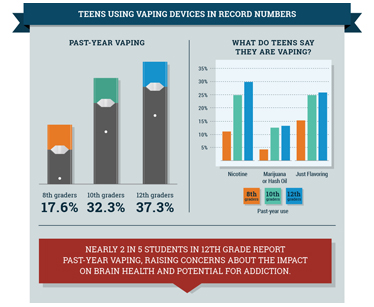
While there is still a lot to be learned about the effects of vaping, one thing is clear, its popularity is on the rise. Sitting at a red light you will see white clouds billowing out of cracked windows and gas station counters are cluttered with liquids, pens, chargers and other vaping paraphernalia. Over the last decade, vaping and e-cigarettes have become engrained in our culture.
Unfortunately, the group taking to the trend most quickly is teens. According to the National Institute of Health, in 2018, 37.3 percent of 12th graders reported vaping within the past 12 months. That number rose almost 10 percent from just the year prior. Throughout the country, teens are vaping both tobacco and marijuana products. After relatively short periods of time some are also finding themselves hospitalized with symptoms such as cough, shortness of breath, vomiting, diarrhea, fever and weight loss. These are all symptoms of vaping-related illness.
Throughout the country hundreds of teens have fallen ill as a result of vaping. The easy access to the products, enticing flavors such as cotton candy, donuts, Fruit Loops and mint, paired with the lack of state and federal regulations, makes the products popular among teens.
Dr. Richard Reno, a pediatrician at White-Wilson’s Destin Clinic, offers some tips for helping adults understand the issue and prevent the children in their lives from engaging in this dangerous behavior.
1. Familiarize yourself with how these products are sold and what they look like. Many popular devices look like USBs, pens and car keys. A little research will help you know what to look for and how these products are hidden and disguised.
2. Talk with kids before they begin vaping. It is important to have conversations before they are faced with the choice to experiment with tobacco, drugs or alcohol. Age-appropriate conversations should be had throughout a child’s life, not just when you suspect they are engaging in something they shouldn’t.
3. Encourage children to think critically not to just listen to their friends. They should always do their own research before making risky choices.
4. Understand your child’s brain. This may seem like a challenge, but adults should understand that a child’s brain develops throughout the teen years and into the early 20s. This time of development means that teens are more prone to impulsive behaviors and addiction. Tobacco, drugs and alcohol have greater effect on the teen brain than that of an adult.
5. Be vigilant. You should be alert to any changes a child’s mood, appearance or behavior that might be warning signs and talk with your child’s pediatrician if you have concerns.
While the long-term health effects of vaping are yet to be understood, this risky behavior is one that adults should not take lightly. Parents, teachers, physicians and loved ones must work together to help prevent the spread of vaping and educate teens on the negative health consequences of using these products.
Dr. Richard Reno is a board-certified pediatrician with more than 25 years of experience. He cares for pediatric patients at the White-Wilson Pediatric Clinic in Destin and is now accepting new patients.


